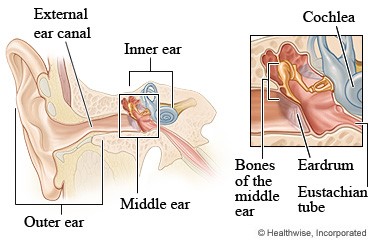Middle Ear Fluid and Middle Ear Problems in Children
What you need to know

What is a middle ear problem?
When fluid or infection collects in your child’s middle ear (the space behind the eardrum), their middle ear may not work normally. This can cause temporary hearing problems.
Some children are more likely to get ear infections than other children.
Often, a middle ear problem (also called middle ear dysfunction) will clear up on its own. Your child’s healthcare provider will discuss treatment with you based on your child’s needs. Some children don’t need treatment.
If your child has a middle ear problem, healthcare providers will monitor their middle ear and their hearing to ensure they return to normal. Persistent untreated middle ear problems can cause more serious ear problems and can also impact your child’s hearing, listening, talking, attention, and learning.
Who will monitor my child’s hearing and middle ear status?
- Audiologist: An audiologist will check to see if there is middle ear fluid and if there is a hearing problem. If they find a hearing problem, the audiologist will repeat hearing tests as needed for your child. The audiologist may recommend other follow-up appointments for your child.
- Family doctor or pediatrician: Your child’s doctor can check their ear for fluid or infection. They may recommend medicines for your child. They may also refer your child to an ear, nose, and throat (ENT) specialist if problems with the ears continue.
- Ear, nose, and throat (ENT) specialist: An ENT can make additional recommendations for ways to help improve the health of your child’s ears. This might include medicine or surgery to place tubes in your child’s eardrums.
What causes middle ear fluid?
The Eustachian tube connects the middle ear to the back of the throat. This tube helps to air out and drain the middle ear.
The Eustachian tube can become blocked because of anatomy (the shapes and structure of body parts), congestion, or colds causing more mucus and swelling.
When the Eustachian tube is blocked, negative middle ear pressure is created. This can lead to fluid building up behind the eardrum.
What are the signs and symptoms of middle ear problems?
Middle ear fluid most often develops during or after a cold. It can sometimes develop due to allergies.
Signs of middle ear problems can include:
- ear pain or discomfort from the pressure of the fluid building up in the middle ear space
- fever
- irritability
- fluid draining from the ears
- decreased hearing
If you think that your child has an ear infection, call your doctor or pediatrician. If you’re not sure if your child’s symptoms need urgent care, call Health Link at 811.
Learn more about childhood ear infections and ear pain.
To see this information online and learn more, visit https://myhealth.alberta.ca/health/aftercareinformation/pages/conditions.aspx?hwid=custom.ab_fluid_middle_ear_problems_child_inst.

For 24/7 nurse advice and general health information call Health Link at 811.
Current as of: February 9, 2023
Author: Provincial Audiology Professional Practice, Alberta Health Services
This material is not a substitute for the advice of a qualified health professional. This material is intended for general information only and is provided on an "as is", "where is" basis. Although reasonable efforts were made to confirm the accuracy of the information, Alberta Health Services does not make any representation or warranty, express, implied or statutory, as to the accuracy, reliability, completeness, applicability or fitness for a particular purpose of such information. Alberta Health Services expressly disclaims all liability for the use of these materials, and for any claims, actions, demands or suits arising from such use.
